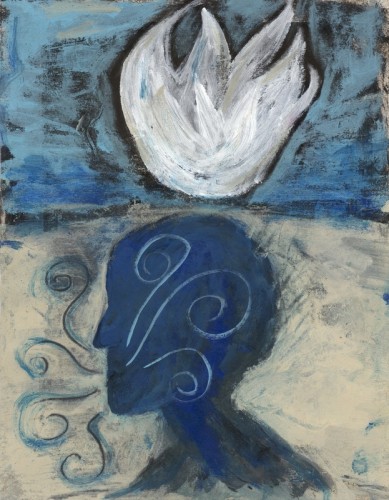Pranayama
When I began practicing yoga, I felt intimidated by the breathing instructions offered by my teacher. Not because her instructions weren’t clear, but because I was worried that I wasn’t breathing the “right” way. Then I learned that pranayama—an integral aspect of yoga practice—is not about “breathing right.” Rather, it’s about changing and controlling your breath to affect the body and mind in positive way. . . .
In the yogic tradition, prana is much more than breath. Prana is energy. Not the kind you either feel you have or don’t have depending on how tired or alert you are. Rather, it’s the energy you are. It’s not separate from you. Pranayama, then, involves intentionally shifting this energy. (The word itself is a combination of two Sanskirt words: “prana,” meaning “life,” and “yama,” meaning “control.”) Depending on the practice you choose, the result can be invigorating or calming, warming or cooling. Pranayama practices can enhance your experience of asana, steady the mind for meditation, or help you slide to sleep. When practiced diligently, some pranayama practices can also help lower your heart rate, lower blood pressure, and increase respiratory capacity.
Step-by-step instructions for some of the most common pranayama practices appear below, with a focus on the breathing practices I offer in my own classes. I hope you find these techniques helpful. And remember, don’t worry about breathing right or wrong: just breathe!
![]()
Alternate-Nostril Breath (Nadi Shodhana, Nadi Suddhi)
 As the name implies, this practice involves coordinating your breath with a regular pattern of closing and releasing your nostrils with your fingertips. In short: you inhale through one nostril, then exhale through the other, alternating nostrils as you go. It may seem awkward at first, but with practice, alternate-nostril breathing will feel rhythmic, familiar, and soothing.
As the name implies, this practice involves coordinating your breath with a regular pattern of closing and releasing your nostrils with your fingertips. In short: you inhale through one nostril, then exhale through the other, alternating nostrils as you go. It may seem awkward at first, but with practice, alternate-nostril breathing will feel rhythmic, familiar, and soothing.
The ancient yogis believed that our nostrils access two key energy channels, or nadis, that run along the length of the spine, intersecting like a DNA double helix. Left nostril breathing stimulates the ida channel, which corresponds to the right side of the brain (the side associated with emotions and creativity); right nostril breathing activates the pingala channel, which corresponds to the brain’s left side (associated with logic). The yogis believed that alternate-nostril breathing cleared and purified these nadis, allowing prana to flow more easily and bringing both hemispheres of the brain in synch.
There are variations of this pranayama; a step-by-step description of the basic practice follows:
- Sit comfortably and upright. Gently blow your nose to clear the nostrils
- Curl the fingers of your right hand into the palm, then release the thumb, ring finger, and pinky. You will use the thumb to seal your right nostril, and the ring finger to seal the left nostril
- Begin with a few natural breaths. Then, after an exhale, close the right nostril with your thumb and inhale through the left nostril only
- When the inhale is complete, close the left nostril with your ring finger, release the right nostril, and exhale
- After the exhale is complete, breathe in through the right nostril. When this inhale is complete, close the right nostril
- Release the left nostril and exhale completely. When the exhale is complete, breathe in fully through the left nostril
- When the inhale is complete, seal the left nostril, then release your right nostril and exhale
- This completes one cycle. Continue the practice for 3 to 5 more cycles, then release both nostrils and return to your normal breath
- Work up to practicing alternate-nostril breath for 5 to 15 minutes at a time
Benefits
- Helps to lower pulse rate
- Helps to lower blood pressure
- Improves respiratory efficiency
- Reduces anxiety
- Assists in clearing the nasal passages
- Helps bring oxygen to both sides of the brain, promoting optimal functioning
Variations
Once you are comfortable with the basic practice, try the following:
- After inhaling, pause and hold the breath for a few seconds before releasing into the exhale
- Experiment with lengthening your exhale; for example, if you breathe in for a count of 6, try to exhale for a count of 8. See if you can work your way up to an exhale that is twice as long is the inhale
Contraindications
- Sinus infection, severe cold, blockage in one or both nostrils
Practice tips
- Do not pinch the nostril closed; lightly pressing at the top of the flared part of the nostril will seal it shut
- Remember, you always alternate nostrils after an inhale
Sitali: the Cooling Breath

Are you sweltering on a steamy summer day? Or just hot and agitated? This cooling pranayama practice can help soothe your simmering body temperature as well as your boiling brain. In this practice, your inhaled breath is moisturized as you draw it into your mouth–picture water droplets on a curling leaf. To try this practice, perform the following steps:
- Sit comfortably and upright
- Extend your tongue in a tube-like shape–in other words, with a valley in the center–and suck in the breath with a hissing sound (as if you were sipping in the air through a straw)
- Draw the tongue in, close the lips, and hold the breath for several seconds (you can eventually work up to holding the breath for 5-10 seconds)
- When ready, exhale the breath through the nose
- Repeat the breath at least 5 times
- Try to practice Sitali for several minutes at a time. Repeat throughout the day as needed/desired
- Work up to a 5- to 10-minute practice of Sitali if you’re hot, hot, hot!
Benefits
- Cools the body
- Calms the mind
- May help combat fatigue
Practice tips
- Swallow before you exhale and notice the yummy cooling sensation in your throat
- Practice Sitali in front of a mirror if you’re not sure if your tongue is making the tube shape
- Tongue challenged? Try an alternate practice (known as Sitkari): stick the tip of the tongue out, hiss the breath in, and continue as outlined above
Ujjayi: the Victorious breath

The smooth and steady Ujjayi breath is often described by the sounds it makes: the rolling waves of the ocean, a whistling teapot, a whisper or soft hiss. Ujjayi doesn’t sound the same for everyone. Notice and enjoy the sounds of your own breath without self-judgement.
Ujjayi breath is created by contracting the glottis muscles at the back of the throat, narrowing the entrance to the windpipe. This adds resistance, causing friction as the air passes through the throat. Like all slow-paced pranayama, Ujjayi has a calming effect on the mind. Ujjayi is also invigorating, as this practice requires increased respiratory effort, which in turn increases the heart rate.
Before you practice Ujjayi, you will need to get a sense of what it feels like to contract the throat:
- Curl your palm and hold it close to your mouth
- Pretend your palm is a fogged mirror. Breathe in through your nose, and exhale out the mouth to “clear” the mirror
- Repeat several times, observing the sensation you feel in your throat (and the warmth of the breath on your palm). Notice the sound your breath makes as you exhale
Now, on to Ujjayi:
- Sit or lie down comfortably, your hands at rest
- Inhale through the nose. Keeping your mouth closed, exhale through the nose while constricting the throat
- Continue breathing, narrowing the throat on inhale and exhale
- Keep your breath smooth and steady, nestling your awareness into the soothing sound of Ujjayi
- Work up to practicing Ujjayi for 5 to 15 minutes at a time
Benefits
- Calms the mind, reducing wandering thoughts
- Increases control and awareness of breath
- Boosts focus and endurance during asana practice, particularly during vinyasa-style yoga
- Increases oxygen saturation (the amount of oxygen in the blood)
- May increase heart rate
- May improve cardiac-vagal baroreflex sensitivity (BRS), a measure of the heart’s ability to effectively regulate blood pressure
Contraindications
- Do not practice Ujjayi if you are feeling out of breath or if you are struggling to breath through a stuffy nose
Variations
- Ujjayi is typically practiced with throat constriction during both inhale and exhale. However, research has suggested that engaging Ujjayi on exhale only may offer greater BRS benefit than Ujjayi with inhale and exhale
- Practicing Ujjayi with exhale alone may increase the calming benefit of the pranayama, as it eliminates the increased effort on inhalation
Practice tips
- If your breath sounds raspy when practicing Ujjayi, you may be working too hard. To avoid strain, alternate Ujjayi breaths with some normal breaths
Pranayama Variations
The following breathing practices are based on, or inspired by, classic pranayama. I often incorporate these practices into my classes and my own home practice.
Rhythm Breath
A valuable tool for calming mind and body,  interval (or rhythmic) breathing is one of my favorite and most-used breathing practices. There are various ways of breathing rhythmically. The practice outlined here, which I have named Rhythm Breath, was inspired by the centering breath technique described by Judith Lasater in her book Relax and Renew.
interval (or rhythmic) breathing is one of my favorite and most-used breathing practices. There are various ways of breathing rhythmically. The practice outlined here, which I have named Rhythm Breath, was inspired by the centering breath technique described by Judith Lasater in her book Relax and Renew.
Practiced before bedtime, Rhythm Breath can help you fall asleep; practiced when you’re angry, it can help prevent you from punching a wall. At work, you can use the Rhythm Breath to give you much-needed breather–literally!–between tasks.
Rhythm Breath does not create any loud or unusual breathing sounds; nor does it require any hand movements. Thus, it can be practiced as effectively on a subway train as on your comfy couch. Plus, it’s easy to learn and remember:
- Sit (or recline) comfortably, with your hands resting on your lap or belly. Allow your eyes to close if you can
- Ask the body to let go, letting tension release from the feet, legs, belly, hands, shoulders, and face
- Breathe normally for several cycles, noting the approximate length of your inhale. For example, count the length of your inhale in oms–“1 om, 2 om,” etc.–or use another counting method that works for you
- Once you have a baseline number to work with, extend your inhale by a count of 2 or 3
- Follow that long inhale with an exhale of the same length
- Return your breath to its normal rhythm for several cycles. Then, when you’re ready, take another extended breath
- Repeat the process, alternating one long breath with several normal breaths for 3-10 rounds
Benefits
- Calms and clears the mind
- Helps to release muscular tension
- May increase respiratory capacity
- Can help lower blood pressure
Contraindications
- Sinus infection, severe cold
Practice tips
- If you feel lightheaded while practicing Rhythm Breath, return to your normal breath pattern, and try the Rhythm Breath another time
- Add a soothing mantra to your practice: for example, when you take the longer breath, say to yourself: “easy inhale, smooth exhale.” Choose a mantra that works for you
![]()
Lotus Mind illustration: © Antaratma Images | Dreamstime.com; Leaf photo: © Mike Ehrman | Dreamstime.com; Ocean wave photo: ©Louise Fecher/yogabright.com; Perching butterfly photo: © Louise Fecher/yogabright.com.




